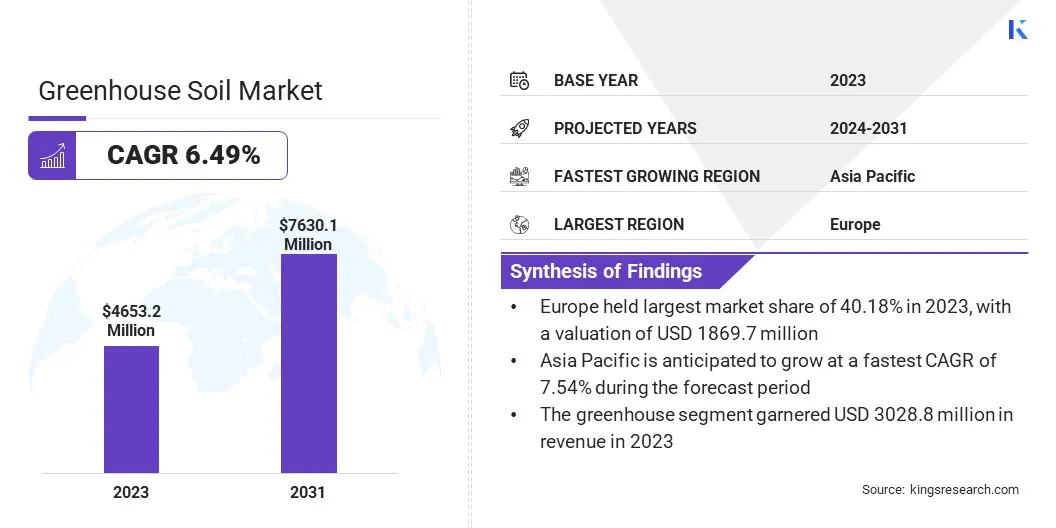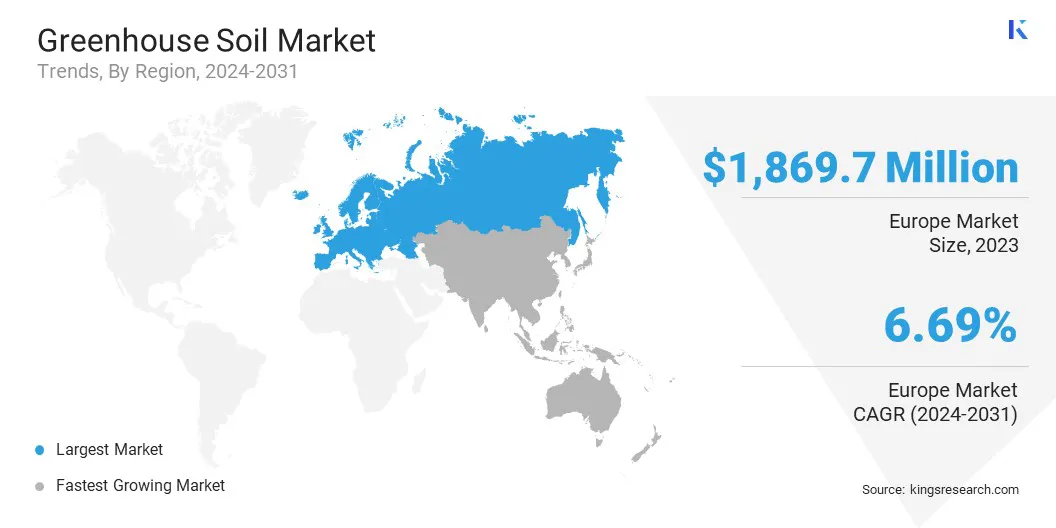Market Definition
Greenhouse soil is a specialized growing medium designed for greenhouse environments, offering optimal conditions for plant growth. It is a blend of organic materials like peat moss, compost, or coconut coir, combined with mineral components such as perlite, sand, or vermiculite to ensure proper aeration, drainage, and moisture retention. Greenhouse soil is typically sterilized to prevent pests, weeds, and diseases, creating a controlled and healthy growing environment.
It is also enriched with essential nutrients and amendments to support plant development. Greenhouse soil provides consistency in quality, allowing for year-round cultivation of vegetables, flowers, and herbs, promoting strong root growth.
Greenhouse Soil Market Overview
The global greenhouse soil market size was valued at USD 4,653.2 million in 2023 and is projected to grow from USD 4,914.5 million in 2024 to USD 7,630.1 million by 2031, exhibiting a CAGR of 6.49% during the forecast period.
Major companies operating in the greenhouse soil industry are Agra Tech, Inc., ASB Grünland Helmut Aurenz GmbH, Florentaise, FoxFarm Soil & Fertilizer Co, Garden Health, Good Earth, Klasmann-Deilmann GmbH, Luiten Greenhouses, Michigan Peat Company, The Scotts Company LLC, Premier Tech Ltd., COMPO, Lambert, Sun Gro Horticulture, Espoma Company, and others.
The expansion of greenhouse farming is significantly contributing to the growth of the market. Controlled-environment agriculture enables year-round cultivation, ensuring stable production and higher yields. This shift toward protected cultivation methods has increased the need for high-quality soil formulations that enhance aeration, moisture retention, and nutrient availability.
Commercial growers often invest in premium soil solutions to optimize plant health and productivity. The rising adoption of greenhouse technology in regions with uncertain climatic conditions has further accelerated market growth, positioning greenhouse soil as a critical input for efficient and sustainable agricultural production.
- A recent study conducted by the University of Copenhagen in June 2024 highlighted the rapid expansion of greenhouse cultivation worldwide. Greenhouses are now present in 119 countries, with China dominating the sector, accounting for 60.4% of the total cultivated area. Spain and Italy follow closely accounting for 5.6% and 4.1% of global greenhouse coverage, respectively.

Key Highlights:
- The greenhouse soil industry size was recorded at USD 4,653.2 million in 2023.
- The market is projected to grow at a CAGR of 6.49% from 2024 to 2031.
- Europe held a market share of 40.18% in 2023, with a valuation of USD 1,869.7 million.
- The peat-based soil segment garnered USD 2,051.6 million in revenue in 2023.
- The greenhouse segment is expected to reach USD 5,363.0 million by 2031.
- Asia Pacific is anticipated to grow at the fastest-growing CAGR of 7.54% during the forecast period.
What are the major factors driving market growth?
Government initiatives promoting sustainable agriculture and controlled farming have positively influenced the greenhouse soil market. Subsidies and financial incentives are encouraging growers to invest in greenhouse infrastructure and high-quality soil formulations.
- In January 2025, the Government of India extended the one-time special subsidy on Diammonium Phosphate (DAP) fertilizer, setting the rate at approximately USD 42 per metric ton. This subsidy, effective from January 1, 2025, will remain in place until further notice.
Research and development efforts are focusing on enhancing soil productivity while minimizing environmental impact. Policies supporting organic farming, regenerative agriculture, and climate-resilient soil solutions are creating growth opportunities for market players. Investments in agricultural modernization and smart farming techniques are strengthening the adoption of premium soil blends, positioning greenhouse soil as a key component in sustainable food production systems worldwide.
What are the major obstacles for this market?
Disruptions in the supply chain are posing a significant challenge to the growth of the greenhouse soil market. This is affecting the availability and cost of essential raw materials such as organic compost, peat alternatives, and nutrient additives. Fluctuations in transportation costs, geopolitical tensions, and regulatory restrictions on soil components are further complicating procurement processes.
To address these challenges, companies are diversifying supplier networks, sourcing raw materials locally, and investing in sustainable alternatives such as bio-based soil enhancers. Additionally, advancements in soil processing technologies are improving manufacturing efficiency, enabling manufacturers to maintain product quality while reducing dependency on volatile supply chains.
Which technological trends are shaping the market?
The rise of vertical farming and hydroponic cultivation has expanded the scope of the greenhouse soil market. Urban agriculture initiatives are increasing the demand for customized soil blends that support plant growth in space-constrained environments. Advanced soilless growing mediums, including coconut coir and peat-based substrates, are gaining traction due to their critical role in hydroponic systems.
The shift toward precision farming has further driven the need for specialized soil formulations that optimize nutrient availability and root support. As urban farming solutions continue to evolve, the demand for innovative greenhouse soil products is expected to grow, fueling market expansion.
- In December 2023, Coop Norway, the country’s second-largest retailer, partnered with Norwegian plant factory developers Avisomo to establish Himmelgrønt AS. This newly launched company will oversee the development of a fully automated vertical farm in Norway.
Greenhouse Soil Market Report Snapshot
|
Segmentation
|
Details
|
|
By Product Type
|
Peat-Based Soil, Coco Coir Soil, Perlite and Vermiculite, Compost Soil, Others
|
|
By Application
|
Greenhouse, Lawn & Landscaping, Indoor Gardening, Others
|
|
By Region
|
North America: U.S., Canada, Mexico
|
|
Europe: France, UK, Spain, Germany, Italy, Russia, Rest of Europe
|
|
Asia-Pacific: China, Japan, India, Australia, ASEAN, South Korea, Rest of Asia-Pacific
|
|
Middle East & Africa: Turkey, UAE, Saudi Arabia, South Africa, Rest of Middle East & Africa
|
|
South America: Brazil, Argentina, Rest of South America
|
Market Segmentation:
- By Product Type (Peat-Based Soil, Coco Coir Soil, Perlite and Vermiculite, Compost Soil, and Others): The peat-based soil segment earned USD 2,051.6 million in 2023 due to its superior water retention, aeration, and nutrient-rich composition, which enhance plant growth and yield efficiency in controlled cultivation environments.
- By Application (Greenhouse, Lawn & Landscaping, Indoor Gardening, and Others): The greenhouse segment held 65.09% of the market in 2023, due to the rising adoption of controlled agriculture practices, which enhance crop yields, optimize resource efficiency, and ensure year-round farming of fresh produce.
What is the market scenario in Europe and Asia-Pacific region?
Based on region, the global market has been classified into North America, Europe, Asia Pacific, Middle East & Africa, and Latin America.
The Europe greenhouse soil market share stood around 40.18% in 2023 in the global market, with a valuation of USD 1,869.7 million. The shift toward organic farming practices has fueled the demand for eco-friendly greenhouse soils. European consumers are increasingly prioritizing sustainably grown produce, leading to a surge in organic-certified soil formulations that enhance plant health without synthetic additives.

Regulatory frameworks promoting sustainable agriculture have further supported this transition, encouraging farmers to adopt bio-based soil amendments such as compost-rich and peat-free growing mediums.
- As part of the Green Deal’s Farm to Fork strategy, the European Commission aims to have at least 25% of the EU’s agricultural land dedicated to organic farming.
Countries such as Spain, Italy, and the Netherlands are investing in advanced greenhouse structures to optimize agricultural productivity. Rising demand for year-round crop cultivation has accelerated the need for high-quality soil solutions that enhance moisture retention, aeration, and nutrient absorption.
The growing preference for controlled-environment agriculture has encouraged greenhouse operators to adopt specialized soil formulations for different crops, promoting market expansion across the region.
Asia Pacific is poised for significant growth at a robust CAGR of 7.54% over the forecast period. Governments across Asia-Pacific are introducing favorable policies and subsidies to promote sustainable farming practices, creating a conducive environment for greenhouse soil industry growth.
China’s push for modernized agriculture, India’s initiatives to support greenhouse farming through subsidies, and Australia’s investments in climate-resilient farming techniques are strengthening the adoption of high-performance soil solutions in the Asia Pacific.
Regulatory frameworks encouraging organic farming and eco-friendly soil amendments have further accelerated market expansion. These government-backed initiatives are fostering technological advancements in soil composition, enhancing its role in controlled-environment agriculture, which is expected to positively impact the greenhouse soli market.
Regulatory Frameworks
- In the U.S., the Environmental Protection Agency (EPA) regulates soil amendments under the Federal Insecticide, Fungicide, and Rodenticide Act (FIFRA) when they claim pesticidal properties. Additionally, the U.S. Department of Agriculture (USDA) oversees organic certification through the National Organic Program (NOP), which sets standards for organic soil inputs. State-level regulations may also apply, particularly concerning the use of biosolids and compost in soil products.
- In Europe, the European Union (EU) implements comprehensive regulations to promote sustainable agriculture and environmental protection. The EU Fertilising Products Regulation (Regulation (EU) 2019/1009) establishes criteria for fertilizers, soil improvers, and growing media, ensuring safety, quality, and labeling standards. The Common Agricultural Policy (CAP) includes requirements for farmers that help them adhere to environmental practices to receive subsidies, influencing the use of certain soil products.
- In the UK, the Fertiliser Regulations 1991, as amended, govern the composition and labeling of fertilizers and soil conditioners. The UK is also introducing the Environmental Land Management Scheme (ELMS), which will incentivize sustainable farming practices, potentially impacting the use of greenhouse soils.
- In China, the Ministry of Agriculture and Rural Affairs regulates fertilizers and soil conditioners, requiring registration and compliance with national standards. The country is focusing on sustainable agricultural practices to address environmental concerns, which may influence the regulation of greenhouse soil products.
- India's Fertilizer (Control) Order, 1985, under the Essential Commodities Act, regulates the manufacture, sale, and distribution of organic and biofertilizers. The order specifies standards for quality, packaging, and labeling to ensure the availability of quality fertilizers to farmers.
Competitive Landscape:
The global greenhouse soil market is characterized by a large number of participants, which includes both established corporations and rising organizations. Market players are strengthening their market presence by expanding production facilities and introducing new product lines to meet evolving industry demands. Investments in new manufacturing units and upgrades to existing facilities are enabling businesses to enhance production capacity and optimize supply chain operations.
Additionally, the launch of innovative soil blends and organic growing media is catering to the increasing preference for sustainable agricultural practices. These strategic initiatives are driving the growth of the market by ensuring a consistent supply of high-quality products tailored to diverse cultivation requirements, supporting both commercial greenhouse growers and small-scale farming operations.
- In October 2024, ScottsMiracle-Gro introduced two new organic products: Miracle-Gro Organic Raised Bed & Garden Soil and Miracle-Gro Organic All Natural Mulch. The soil blend is formulated without peat and is made with upcycled green waste. It is produced within 150 miles of retail outlets to enhance sustainability. Additionally, it features a natural fertilizer designed to nourish plants for up to 2 months, aligning with the growing demand for environmentally friendly gardening solutions.
List of Key Companies in Greenhouse Soil Market:
- Agra Tech, Inc.
- ASB Grünland Helmut Aurenz GmbH
- Florentaise
- FoxFarm Soil & Fertilizer Co
- Garden Health
- Good Earth
- Klasmann-Deilmann GmbH
- Luiten Greenhouses
- Michigan Peat Company
- The Scotts Company LLC
- Premier Tech Ltd.
- COMPO
- Lambert
- Sun Gro Horticulture
- Espoma Company
Recent Developments (Partnerships/ New Product Launch)
- In June 2023, SGS partnered with AgriCircle to deliver innovative solutions focused on soil health and regenerative agriculture. This collaboration seeks to equip farmers and agri-food industry stakeholders with advanced tools and expertise, promoting sustainable farming practices.
- In August 2024, Better Earth launched a Compost Drop-Off Database, linking consumers to local drop-off sites to enhance composting accessibility as part of U.S.’s efforts to address food waste and climate change.


